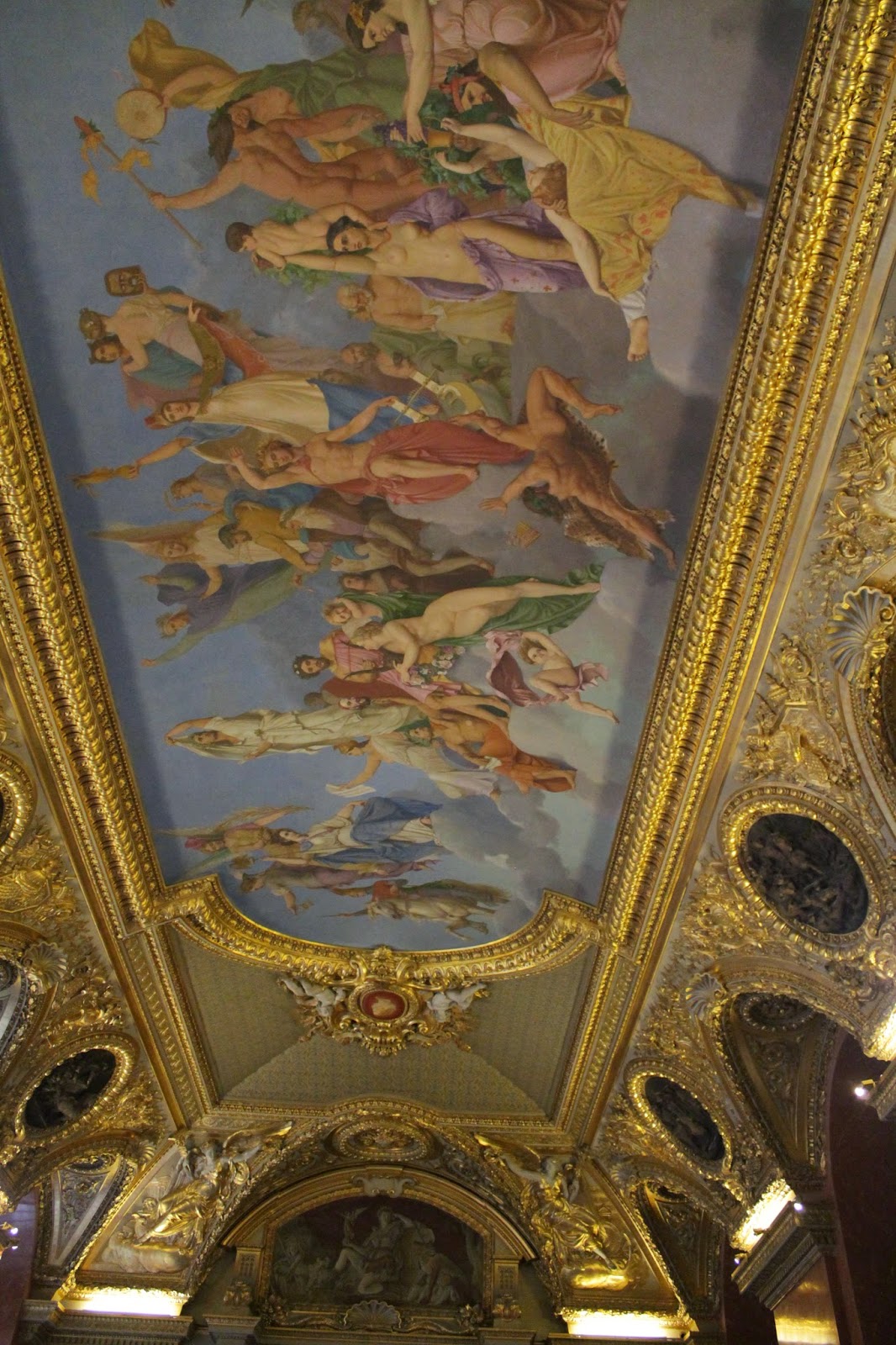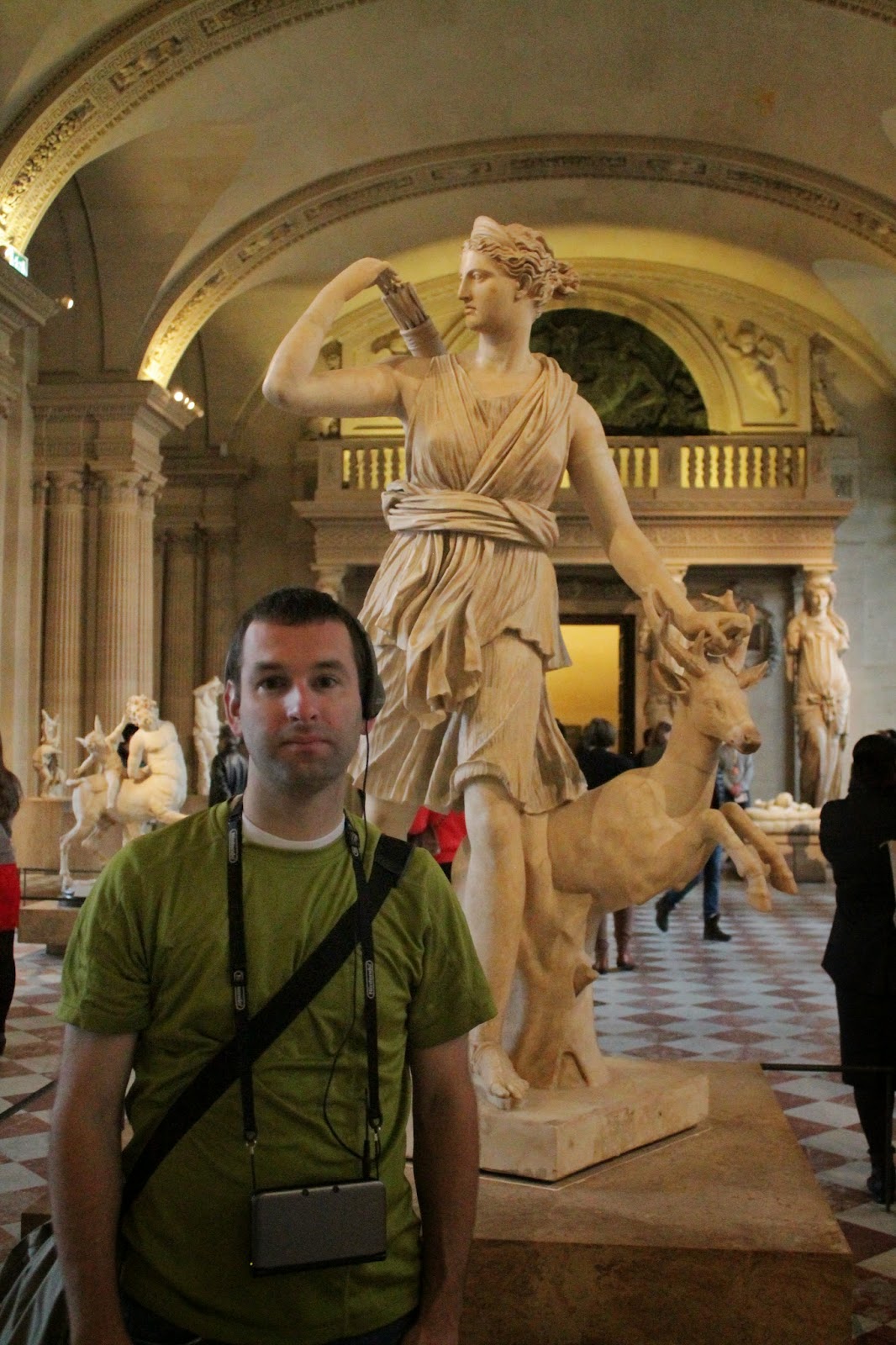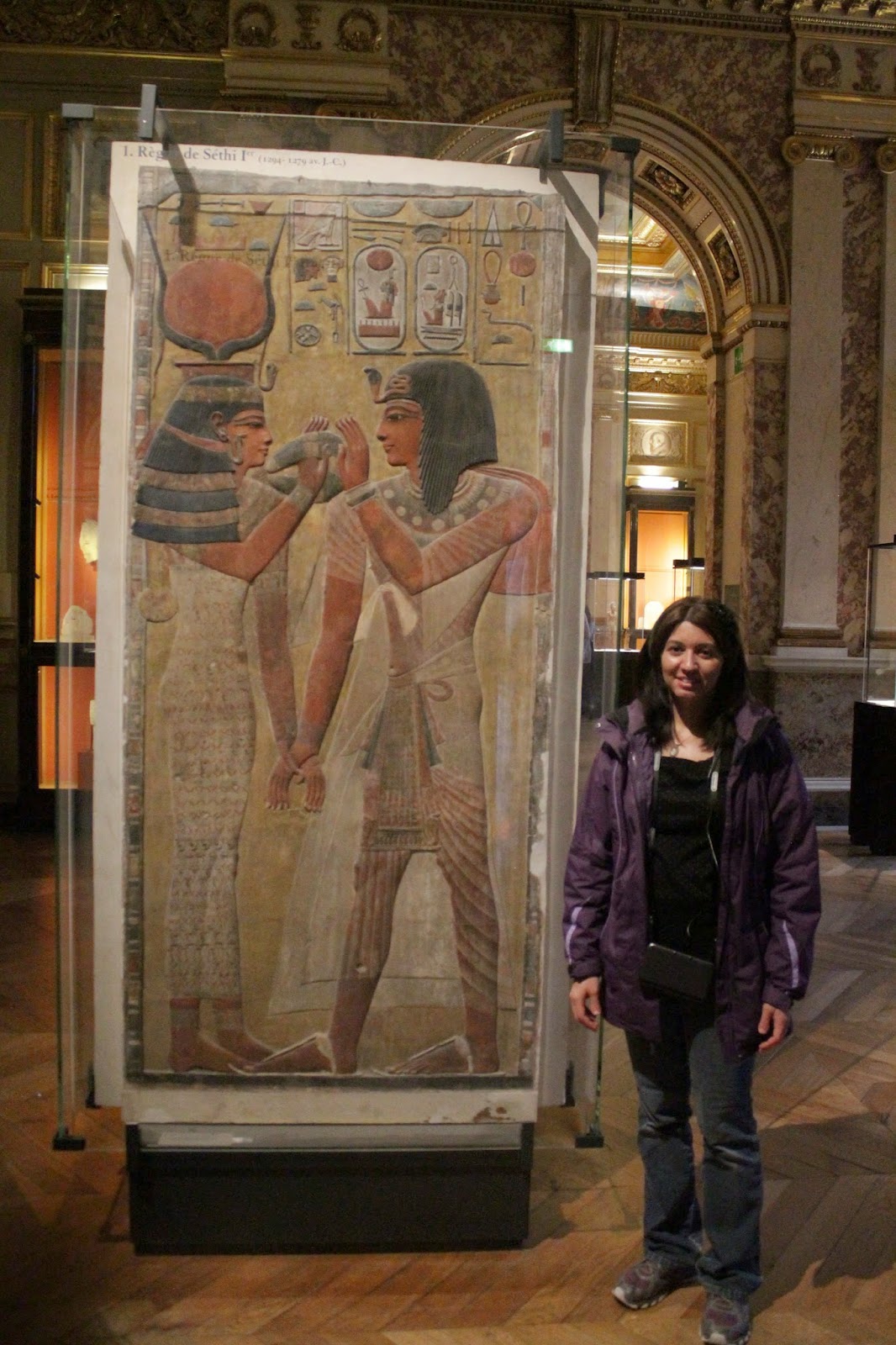I think after our trip to Paris we no longer need to visit any other museum, ever. We've seen all the best stuff now, can't top it. Okay, well maybe we can still go to more museums, but really we saw a lot of cool stuff. Each piece by itself would have been cool to see, but having so many cool things packed in made you miss a lot of neat stuff. People were walking right by some awesome things without giving them a second glance. We probably walked by awesome things without even knowing what we were missing.
The Louvre dates back to the 12th century when it was built as a fortress. It served as a royal palace (much expanded since the fortress days) until Louis XIV moved the royal court to Versailles in 1678. As a palace it is large, as a museum it is gigantic.
In the basement, looking at the oldest section of the Louvre, the base of the fortress. Where I was walking used to be a moat.
The unique thing about the Louvre Palace as a museum is that every room has a history and the decor in every room could be the subject of an art history thesis. Here is a picture of the ceiling from one of the rooms.
Robert thought it was funny/ridiculous seeing people taking pictures with their tablets...
...'cause of course you gotta get a picture with the sphinx, dates to 2600 B.C. Side note, all the paintings in the museum are older than 1850. Art after about 1850 can be found in another National Museum, the Musée d'Orsay, which we also went to and you can expect to read about that in another blog post.
Yeah...I don't remember anything about this one, there were a lot of Greek and Roman statues. So I'll stop here and tell about our cool audio guides that I'm wearing in all the pictures.
The audio guide was actually a Nintendo DS. Rather than making you follow a set route through the Louvre, these audio guides track your location and automatically play an introduction to each room when you walk into the room. Then you are able to select on the screen which work of art in each room you would like to hear more about. Not every piece has an audio clip, but the most important pieces do. But, there is so much information that it would take you weeks to listen to everything. Robert and I decided we would listen to one piece per room, take a quick look at the room, then move on.
We were glad we got the audio guides (like most places, you pay extra for it) because the plaques next to the artifacts and artwork didn't really say anything but the name, artist, and date of the work. Little to no background information, and then it was all in French. We got a lot more out of our experience by knowing the significance of the pieces we selected. The Louvre is huge, so we knew we wouldn't be able to see everything, but we felt like we got a good "sampling" of what is in there.
Venus de Milo (except she is Greek, so really she is Aphrodite), dates to about 130-100 B.C.
Robert thought we should take a picture of the back since we never see the back. It was meant to be placed against a wall because the workmanship of the back is not as fine as the front.
Robert was happy to be looking at ancient statues, he just wasn't excited for me to take his picture.
Now on to the paintings, The next seven pictures are a few of our favorite paintings, not necessarily aesthetically, but because of their back stories or the significance of the painter.
Allegories of the Seasons and the Elements (composite heads), Giuseppe Arcimboldo, 1573
This was one of the most unusual set of paintings we saw. I looked up the artist later and found he really liked to do this kind of painting, using different fruits and objects from nature to make heads. Each one represents the four season and is made out of plants that you would find in each season. It also depicts man's progression through life- childhood, youth, middle age, and old age. Winter is a wizened old man made of mostly dry tree branches (and lemons- maybe to represent bitterness of old age? I don't know, but his work is full of puns like that).
Liberty Leading the People, Delacroix, 1830.
Really famous painting. I was surprised how big it is. I wasn't expecting to see it (but of course, it's an iconic French painting so where else would it be but in the Louvre?) and looked up and said, "Oh! Cool."
Just to throw in that we saw Raphael and his typical chubby baby Jesus.
Death of the Virgin, Caravaggio, 1606
This painting caused quite the outrage when it was painted. It was rejected by the monks who commissioned it for their church because it depicted the Virgin Mary as a normal, deceased, person, and not celestially rising towards heaven as was usually depicted. Also, the artist used a prostitute as a model for Mary. Scandalous!
I forgot the name of this painting, but I put it in because it was one of the few paintings that Robert knew that I had never seen before. It's a scene out of Greek or Roman mythology where the soldiers are taking that lady captive. Now if I could remember the name of the lady I could look it up because I know her name in in the title of the painting, but my mind is blank on this one.
The Coronation of Napoleon, Jacques-Louis David, 1807
Also a huge painting, in fact I believe it is the second largest painting in the Louvre. When the artist completed it he believed it was the largest painting in the world, but he was mistaken. The Wedding Feast at Cana was just slightly larger and is also at the Louvre (in the same room as the Mona Lisa, more in another post). It depicts Napoleon crowning his wife Josephine as Empress of France in the Cathedral Notre Dame de Paris.
David originally painted Napoleon crowning himself, but then changed his mind and changed it to what it looks like now. Supposedly if you look closely at the actual painting you are able to see the original way it was painted with Napoleon leaning back slightly and placing the crown on his own head, but I wasn't able to see it. To fill the gap behind Napoleon where he was suppose to be leaning back, the artist painted a figure who has the features of Julius Caesar.
One thing people always point out about this painting is that the lady sitting on the lower balcony, directly above Josephine in a position of honor, is Napoleon's mother. She actually did not attend the coronation out of protest, but David drew her in anyway at Napoleon's request. The artist also painted a replica of this painting from memory immediately after he finished the original. We also saw the replica on our trip, it is hanging at Versailles.
The Raft of the Medusa, Théodore Géricault, 1819
Another one that Robert knew that I didn't ;). In 1816 the captain of the Medusa, a Royal French Navy ship, mistakenly ran the ship aground after the ship drifted off course. Since there were not enough real lifeboats for everyone, 150 of the soldiers on board were forced to make a raft and for 13 days drifted at sea. There were only 15 survivors when they were finally rescued. This scene depicts the moment when they see the rescue boat. This was painted only a few years after the event which was still widely known and seen as a political embarrassment since the boat ran aground due to the incompetent captain. The artist went to a lot of trouble to get the details right by interviewing survivors, making a model of the raft, and visiting morgues and hospitals to see what the dead and dying look like. He certainly made a splash on the art world when he debuted his painting that year.
Lots of cool stuff, right? I'll go into less detail on these next things, but they are also all awesome artifacts we saw.
Ancient Egyptian Saber.
Scepter of Charles V, dates from 1364
This was an example of awesome that no one was paying attention to. This is the sceptor that all the Kings of France (except two) held while they were being crowned, from Charles V in 1364 to Charles X in 1825. All the Kings-minus Charles VII and Henry IV-touched this sceptor!
Napoleon III living quarters
Armoire belonging to one of the queens.
Empress Eugenie's crown (1855).
The Lacemaker, Vermeer, 1664
We were looking for it because it is one of the more famous Dutch works, and we almost missed it because it's so small. Again, it's cool to see the actual sizes of the paintings because if you were to look this up online you would have no idea how small it is.
While we were looking at these paintings I remarked that Rembrandt seemed to paint a lot of his subjects to look the very similar. Did he not know how to add a little more personalization? Then we realized they all looked similar because they were all portraits of the same person, the artist himself. Apparently there was a good market for portraits of Rembrandt, a lot of people wanted to buy them, so he kept painting them!
























No comments:
Post a Comment